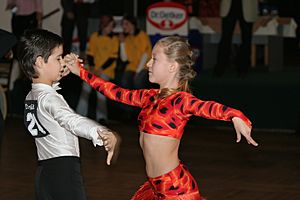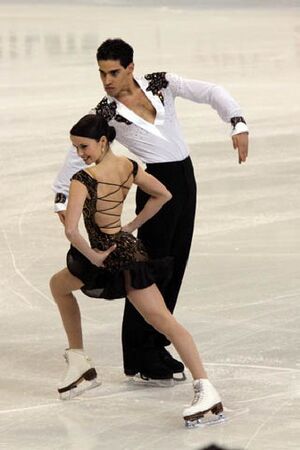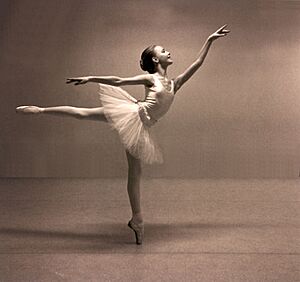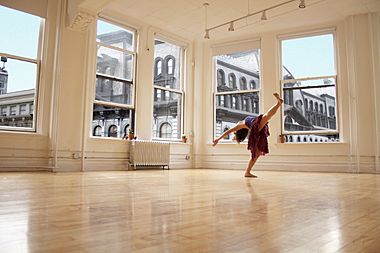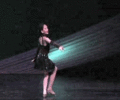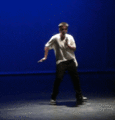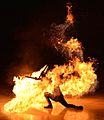Dance facts for kids

Dance is when people move their bodies to a musical rhythm. You can dance alone, or with a group of friends. Dance can be a fun, informal activity. It can also be part of a special ritual or a professional show. There are many types of dances. Almost every human society has its own unique dances.
Dance is a great way to exercise. It can even help you train for other sports. For some, dance has become a sport itself. There are many dance competitions. These shows feature different styles and skill levels.
Dance is also a beautiful art form. Some people dance to show their feelings and emotions. Others dance just to feel better. Dance can even be used to tell a story. In some places, dance goes with songs as well as music. If you want to learn to dance, you can go to dance schools. It often takes many years of practice to become a skilled dancer.
Planning a dance is called choreography. This is done by a choreographer. Often, choreography goes with music and fits a certain style. Dances can be planned in great detail. Or, they can be free-form, where dancers move as they feel. However, most dancing follows some general style or pattern. One common style is the couple dance. Here, two people (usually a man and a woman) dance together. Other dances need a whole group of people to work.
Contents
The History of Dance
People have always danced throughout history. Every society has created its own dances. We have seen pictures on pottery and stone. These pictures show dances from thousands of years ago. They come from places like Egypt and Greece.
Early dances often had different purposes. Some dances aimed to get dancers into a state of ecstasy. In this state, dancers might feel changed or in a trance. People sometimes believed they were "possessed by spirits." These dances happened during important events. This included marriages, wars, or times of illness. Such dances were common in many early societies.
Other early dances were "image dances." These dances were about the world outside the dancer. Dancers would imitate animals or objects. They believed this would help them gain power. For example, dancing like an animal before a hunt. This was thought to make them one with the animal. This kind of thinking was behind image dances. People truly believed these dances would work. A common type of dance used in image dances was mime.
Sometimes, these two dance styles were combined. Dances about fertility might include both ecstatic movements and mime. The famous dancer Nijinsky used these ideas. He created the ballet Le Sacre du Printemps. This ballet was about a girl sacrificed during a spring celebration.
Moving to more recent times, the first known dance school opened in 1661 in Paris. Only men were allowed at first. Women were accepted starting in 1681. Ballroom dances are a type of modern dance. Dances like the waltz are done by couples.
Until the 1900s, many ballroom dances were sequence dances. Dancers moved in planned formations. These were often lines or squares. Everyone moved and finished at the same time. The music played for a set time and then stopped. After the waltz appeared around 1800, a new style grew. In the waltz, couples danced separately. They moved around the room freely, usually counter-clockwise.
New dance styles often appear. Some people dance alone, moving as they please. Street dance is an example of this. All these types of dance have music. Around the world, many traditional dances still exist. Some have been performed for hundreds of years. We call these folkloric dances.
The rise of popular music videos and DVDs created a new type of dancer. This was similar to dancers seen in some stage shows. A backup dancer (or background dancer) performs with or behind the main artists. They appear in live music shows or music videos.
Different Dance Styles
There are many different ways to dance. They can be grouped into these main types:
- Professional Dancing
- Social Dancing
- Ballroom dancing (International style)
- Other styles
- Street dance
- Folk Dance
- Irish Dance
- Morris Dance
- Country Dance
- Indian Classical Dances
- Bharat Natyam
- Kathak
- Mohini Attam
- Kathakali
- Kuchipudi
Learning About Dance
Many colleges and universities offer dance studies. These are part of their arts and humanities programs. Some universities even offer special degrees in Dance. A dance study program might include many different classes. These can cover dance practice, performance, and choreography. You might also learn about dance history or how dance helps with health. Recently, dance and movement therapy has been used in schools. It helps students with learning challenges or ADHD in subjects like math.
Dance Jobs
Dancers
Professional dancers usually work on short-term contracts. They might be hired for specific shows or projects. A dancer's professional life often involves changing jobs. There is also a lot of competition and sometimes low pay. Because of this, many professional dancers do other jobs to earn enough money. In the U.S., many dancers join unions. These unions help set fair working conditions and minimum salaries. Professional dancers need to be very athletic. To have a good career, it helps to be good at many dance styles. A strong technical background and other fitness training are also important.
Teachers
Dance teachers usually focus on teaching dance performance. They might also coach dancers for competitions. Often, they have performed the types of dance they teach. For example, dancesport teachers are often former competitive dancers. Dance teachers can work for themselves. They might also work for dance schools or regular schools with dance programs. Some work for university programs or schools linked to professional dance companies. Others work for smaller, private dance schools. These schools offer training for many types of dance.
Choreographers
Choreographers are the people who create dance movements. They design how dancers will move in a performance. Choreographers often have a university education in dance. They are usually hired for specific projects. Sometimes, they might work as a main choreographer for a dance company.
Dance Competitions
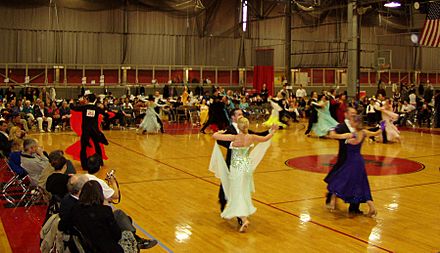
A dance competition is an event where dancers perform for judges. They compete for awards and sometimes money. There are several main types of dance competitions. They are mostly different based on the dance styles performed. Dance competitions are a great way to meet important people in the dance world. This includes judges, choreographers, and other dancers. A typical competition for younger dancers can last two to four days. This depends on if it's a local or national event.
The goal of dance competitions is to provide a fun and educational space. Dancers get to perform their routines from the current dance season. Competitions often take place in professional venues. They might also be held in places like high school theaters. Judges score the dancers based on their performance. Categories are usually based on dance style, age, experience level, and number of dancers. Major types of dance competitions include:
- Dancesport: This focuses only on ballroom and latin dance.
- Competitive dance: This allows many theater dance styles. Examples include acrobatics, ballet, jazz, hip-hop, lyrical, stepping, and tap.
- Commercial Dance: This includes hip hop, jazz, locking, popping, breakdancing, and contemporary dance.
- Single-style competitions: These only allow one dance style. Examples are highland dance or Irish dance.
- Open competitions: These allow a wide range of dance styles. The TV show So You Think You Can Dance is an example.
- Olympic: Dance has been trying to become an Olympic sport since the 1930s.
Famous Dancers
- Alvin Ailey
- George Balanchine
- Vernon and Irene Castle
- Misty Copeland
- Katherine Dunham
- Bob Fosse
- Loie Fuller
- Gene Kelly
- Vaslav Nijinsky
- Margot Fonteyn
- Monsieur Pierre
- Antonio Ruiz Soler
Images for kids
-
Two modern dancers
-
Two women dance at a pop music concert in Sofia, Bulgaria.
-
The Waltz by Camille Claudel, 1905 cast
-
Tang dynasty female dancers
-
Ugandan youth dance at a cultural celebration of peace
-
An Indonesian Balinese dancer
-
Dance at Bougival by Pierre-Auguste Renoir (1883)
-
Two classical ballet dancers perform a sequence of The Nutcracker, one of the best known works of classical dance.
-
Dance partnering – a male dancer assists a female dancer in performing an arabesque, as part of a classical pas de deux.
-
Acrobatic dance – an acro dancer performs a front aerial.
-
Social dance – dancers at a juke joint dance the Jitterbug, an early 20th century dance that would go on to influence swing, jive, and jazz dance.
-
Latin Ballroom dancers perform the Tango.
-
Harlequin and Columbina from the mime theater in Copenhagen, Denmark
-
Prop dance – a fire dancer performance
-
Stage dance – a professional dancer at the Bolshoi Theatre
-
Ritual dance – Armenian folk dancers celebrate a neo-pagan new year.
-
Street dance – a Breakdancer performs a handstand trick.
-
Kebagh dance from Pagar Alam, Indonesia
See Also
 In Spanish: Danza para niños
In Spanish: Danza para niños


